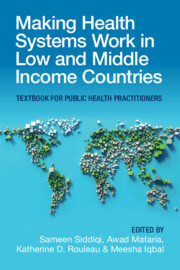 Making Health Systems Work in Low and Middle Income Countries
Making Health Systems Work in Low and Middle Income Countries Lessons from the Thai Experience in Community Engagement
from Section 2 - Transforming Health Systems: Confronting Challenges, Seizing Opportunities
Published online by Cambridge University Press: 08 December 2022
This chapter focuses on how community engagement (CE) can be implemented at the national and sub-national levels. CE has been identified as an essential pillar of strong people-centred governance which is needed to underpin Universal Health Coverage (UHC) reforms. The “whole of society approach” acknowledges the importance of families and communities in support of the efforts for disease prevention and control. It provides an overview of the evidence and outlines processes that enable effective community engagement and highlights lessons drawn. In particular, Thailand’s Universal Coverage Scheme’s (UCS) participatory governance approach has been a practical example and one of the myriad ways in which the voice of Thailand’s people has been embedded in legislations and operations to ensure that the governance of UCS is responsive to their needs. Four lessons from this experience include leadership and commitment at all levels, transparency and accountability to enable sustained engagement, legal frameworks, and the need for strong capacities in both the government and among communities. Lastly, it proposes the lessons learned and key messages for a proactive approach to CE in health.
To save this book to your Kindle, first ensure no-reply@cambridge.org is added to your Approved Personal Document E-mail List under your Personal Document Settings on the Manage Your Content and Devices page of your Amazon account. Then enter the ‘name’ part of your Kindle email address below. Find out more about saving to your Kindle.
Note you can select to save to either the @free.kindle.com or @kindle.com variations. ‘@free.kindle.com’ emails are free but can only be saved to your device when it is connected to wi-fi. ‘@kindle.com’ emails can be delivered even when you are not connected to wi-fi, but note that service fees apply.
Find out more about the Kindle Personal Document Service.
To save content items to your account, please confirm that you agree to abide by our usage policies. If this is the first time you use this feature, you will be asked to authorise Cambridge Core to connect with your account. Find out more about saving content to Dropbox.
To save content items to your account, please confirm that you agree to abide by our usage policies. If this is the first time you use this feature, you will be asked to authorise Cambridge Core to connect with your account. Find out more about saving content to Google Drive.